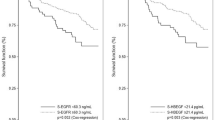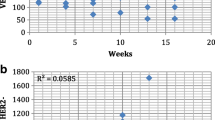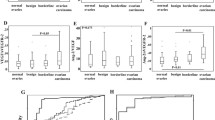Abstract
Introduction
To investigate the value of baseline serum levels of VEGF, bFGF, endostatin and their ratio as predictive factors of response to endocrine therapy in patients with metastatic breast cancer (MBC) and positive ER treated with letrozole after tamoxifen failure.
Materials and method
The serum levels of endostatin, VEGF and bFGF were determined in post-menopausal patients with progressing MBC from serum samples obtained before initiation of letrozole. The relation between serum angiogenic factor levels and TTP was investigated.
Results
Seventy-six patients (45.2%) presented a high endostatin level (>24.6 ng/ml), 40% low bFGF levels (0 pg/ml) and 50.4% low VEGF (≤187 ng/ml). With a median follow-up of 22 months, the median TTP was 12.3 months. Median TTP was worse in patients with high endostatin concentration as well as in the low bFGF group, but was not affected when VEGF was considered. When the two factors were combined, the median TTP of patients with endostatin >24.6 ng/ml and bFGF equal 0 pg/ml was 9.5 months versus 19.5 months in patients with endostatin ≤24.6 ng/ml and bFGF>0 pg/ml.
Conclusions
The baseline levels of bFGF and endostatin are predictive factors of efficacy in patients with MBC treated with letrozole and can select groups with different TTP.
Similar content being viewed by others
References
Osborne CK. Tamoxifen in the treatment of breast cancer. N Eng J Med. 1998;339: 1609–18.
Mouridsen H, Gershanovich M, Sun Y, et al. Phase III study of letrozole versus tamoxifen as first-line therapy of advanced breast cancer in postmenopausal women: analysis of survival and update of efficacy from the International Letrozole Breast Cancer Group. J Clin Oncol. 2003;21: 2101–9.
Nabholtz JM, Bonneterre J, Buzdar A, Robertson JF, Thurlimann B. Anastrozole (ArimidexTM) versus tamoxifen as first-line therapy for advanced breast cancer in postmenopausal women: survival analysis ad updated safety results. Eur J Cancer. 2003;39:1684–9.
Paridaens R, Dirix L, Lohrisch C, et al. Mature results of a randomized phase II multicenter study of exemestane versus tamoxifen as first-line hormone therapy for postmenopausal women with metastatic breast cancer. Ann Oncol. 2003;14: 1391–8.
Goss PE, Ingle JN, Martino S, et al. A randomized trial of letrozole in postmenopausal women after five years of tamoxifen therapy for early-stage breast cancer. N Engl J Med. 2003;349:1793–802.
ATAC Trialists' Group. Anastrozole alone or in combination with tamoxifen versus tamoxifen alone for adjuvant treatment of postmenopausal women with early breast cancer. Cancer. 2003;98:1802–10.
Clark GM. Prognostic and predictive factors. In: Harris JR, Lippman ME, Morrow M and Osborne CK (Eds). Diseases of the breast. (2nd edition). Philadelphia: Lippincott Williams & Wilkins; 2000, p. 489–514.
Yamauchi H, Stearns V, Hayes DF. When is a tumor marker ready for prime time? A case study of c-erbB-2 as a predictive factor in breast cancer. J Clin Oncol. 2001; 19:2334–56.
Folkmann J. The role of angiogenesis in tumor growth. Semin Cancer Biol. 1992;3: 65–71.
Poon RT, Fan S, Wong J. Clinical implications of circulating angiogenic factors in cancer patients. J Clin Oncol. 2001;19: 1207–25.
Morelli D, Lazzerini D, Cazzaniga S, et al. Evaluation of the balance between angiogenic and antiangiogenic circulating factors in patients with breast and gastrointestinal cancers. Clin Cancer Res. 1998;4:1221–5.
Gasparini G. Prognostic value of Vascular Endothelial Growth Factor in breast cancer. Oncologist. 2000;5 Suppl 1:S37–44.
Colomer R, Aparicio J, Montero S, Guzmán C, Larrodera L, Cortés-Funes H. Low levels of basic fibroblast growth factor (bFGF) are associated with a poor Prognosis in human breast carcinoma. Br J Cancer. 1997;76:1215–20.
Foekens JA, Peters HA, Grebenchtchikov N, et al. High tumor levels of vascular endothelial growth factor predict poor response to systemic therapy in advanced breast cancer. Cancer Res. 2001;61:5407–14.
Manders P, Sweep FC, Tjan-Heijnen VC, et al. Vascular Endothelial Growth Factor are associated with the efficacy of endocrine therapy in patients with advanced breast cancer. Cancer. 2003;98: 2125—21—32.
Kerbel R, Folkman J. Clinical translation of angiogenesis inhibitors. Nat Rev Cancer. 2002;2:727–39.
O'Reilly MS, Boehm T, Shing Y, et al. Endostatin: an endogenous inhibitor of angiogenesis and tumor growth. Cell. 1997; 88:277–85.
Feldman AL, Pak H, Yang JC, Alexander HR Jr, Libutti SK. Serum endostatin levels are elevated in patients with soft tissue sarcoma. Cancer. 2001;91:1525–9.
Suzuki M, Iizasa T, Ko E, et al. Serum endostatin correlates with progression and prognosis of non-small cell lung cancer. Lung Cancer. 2002;35:29–34.
Feldman AL, Alexander HR Jr, Yang JC, et al. Prospective analysis of circulating endostatin levels in patients with renal cell carcinoma. Cancer. 2002;95:1637–43.
Guan KP, Ye HY, Yan Z, Wang Y, Hou SK. Serum levels of endostatin and matrix metalloproteinase-9 associated with high stage and grade primary transitional cell carcinoma of the bladder. Urology. 2003; 61:719–23.
Bono P, Teerenhovi L, Joensuu H. Elevated serum endostatin is associated with poor outcome in patients with Non-Hodgkin Lymphoma. Cancer. 2003;97: 2767–75.
Feldman AL, Alexander HR Jr, Bartlett DL, et al. A prospective analysis of plasma endostatin levels in colorectal cancer patients with liver metastases. Ann Surg Oncol. 2001;8:741–5.
Lai R, Estey E, Shen Y, et al. Clinical significance of plasma endostatin in acute myeloid leukemia/myelodysplastic syndrome. Cancer. 2002;94:14–7.
Hefler L, Tempfer C, Kainz C, Obermair A. Serum concentrations of endostatin in patients with vulvar cancer. Gynecol Oncol. 1999;79:151–2.
Dhar DK, Ono T, Yamanoi A, et al. Serum endostatin predicts tumor vascularity in hepatocellular carcinoma. Cancer. 2002; 95:2188–95.
Kuroi K, Tanaka Ch, Toi M. Circulating levels of endostatin in cancer patients. Oncol Rep. 2001;8:405–9.
Zhao J, Yan F, Ju H, Tang J, Qin J. Correlation between serum vascular endothelial growth factor and endostatin levels in patients with breast cancer. Cancer Lett. 2004;204:87–95.
Teh SH, Hill AD, Lee AW, et al. Raised plasma endostatin levels correlate inversely with breast cancer angiogenesis. J Surg Res. 2004;116:165–71.
Therasse P, Arbuck SG, Eisenhauer EA, et al. New Guidelines to evaluate the response to treatment in solid tumors. J Natl Cancer Inst. 2000;92:205–16.
Miller AB, Hoogstraten B, Staquet M, Winkler A. Reporting results of cancer treatment. Cancer. 1981;47:1218–25.
Faridi A, Rudlowski C, Biesterfeld S, Schuh S, Rath W, Schroder W. Long-term follow-up and prognostic significance of angiogenic basic fibroblast growth factor (bFGF) expression in patients with breast cancer. Pathol Res Pract. 2002;198:1–5.
Guelstein VI, Rchypysheva TA, Ermilova VD, Ljubimov AV. Myoepithelial and basement membrane antigens in benign and malignant human breast tumors. Int J Cancer. 1993;53:269–77.
Miosge N, Sasaki T, Timpl R. Angiogenesis inhibitor endostatin is a distinct component of elastic fibers in vessel walls. FASEB J. 1993;13:1743–50.
Ma L, Elliott SN, Cirino G, Buret A, Ignarro LJ, Wallace JL. Platelets modulate gastric ulcer healing: role of endostatin and vascular endothelial growth factor release. Proc Natl Acad Sci. USA 2001;98: 6470–5.
Dixelius J, Cross MJ, Matsumoto T, Claesson-Welsh L. Endostatin action and intracellular signalling: β-catenin as a potential target? Cancer Lett. 2003;196:1–12.
Wen W, Moses MA, Wiederschain D, Arbiser JL, Folkman J. The generation of endostatin is mediated by elastase. Cancer Res. 1999;59:6052–6.
Felbor U, Dreier L, Bryant RA, Ploegh HL, Olsen BR, Mothes W. Secreted cathepsin L generates endostatin from collagen XVIII. EMBO J. 2000;19:1187–94.
Tomono Y, Naito I, Ando K, et al. Epilopedefined monoclonal antibodies against multiplexin collagens demonstrate that type XV and XVIII collagens are expressed in specialized basement membranes. Cell Struct Funct. 2002;27:9–20.
Iizasa T, Chang H, Suzuki M, et al. Over-expression of collagen XVIII is associated with poor outcome and elevated levels of circulating serum endostatin in non-small cell lung cancer. Clin Cancer Res. 2004; 10:5361–6.
Musso O, Rehn M, Théret N, et al. Tumor progression is associated with a significant decrease in the expression of endostatin precursor collagen XVIII in human hepatocellular carcinomas. Cancer Res. 2001;61:45–9.
Dixelius J, Cross M, Matsumoto T, Sasaki T, Timpl R, Claesson-Welsh L. Endostatin regulates endothelial cell adhesion and cytoskeletal organization. Cancer Res. 2002;62:1944–7.
McLeskey SW, Tobias CA, Vezza PR, Filie AC, Kern FG, Hanfelt J. Tumor growth of FGF or VEGF transfected MCF-7 breast carcinoma cells correlates with density of specific microvessels independent of the transfected angiogenic factor. Am J Pathol. 1998;153:1993–2006.
Ali SH, O'Donnell AL, Balu D, et al. High levels of oestrogen receptor- in tumorigenesis: inhibition of cell growth and angiogenic factors. Cell Prolif. 2001;54:225–31.
Simpson ER, Zhao Y, Agarwal VR, et al. Aromatase expression in health and disease. Recent Prog Horm Res. 1997;52:185–213.
Author information
Authors and Affiliations
Corresponding author
Rights and permissions
About this article
Cite this article
Alba, E., Llombart, A., Ribelles, N. et al. Serum endostatin and bFGF as predictive factors in advanced breast cancer patients treated with letrozole. Clin Transl Oncol 8, 193–199 (2006). https://doi.org/10.1007/s12094-006-0010-3
Received:
Accepted:
Issue Date:
DOI: https://doi.org/10.1007/s12094-006-0010-3




